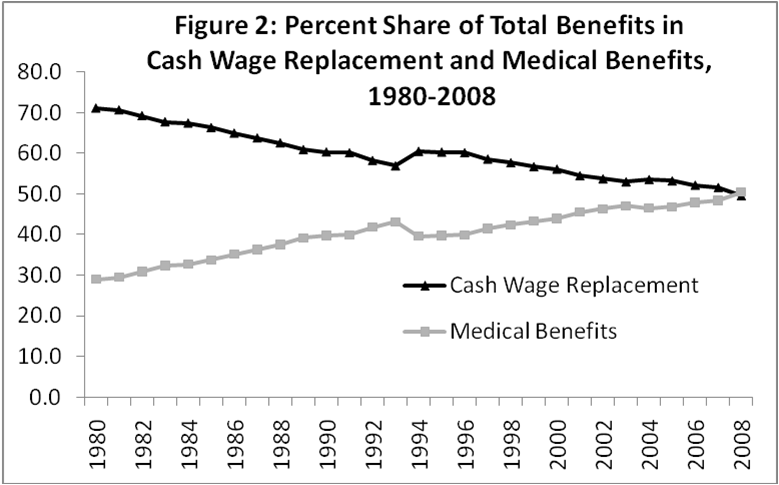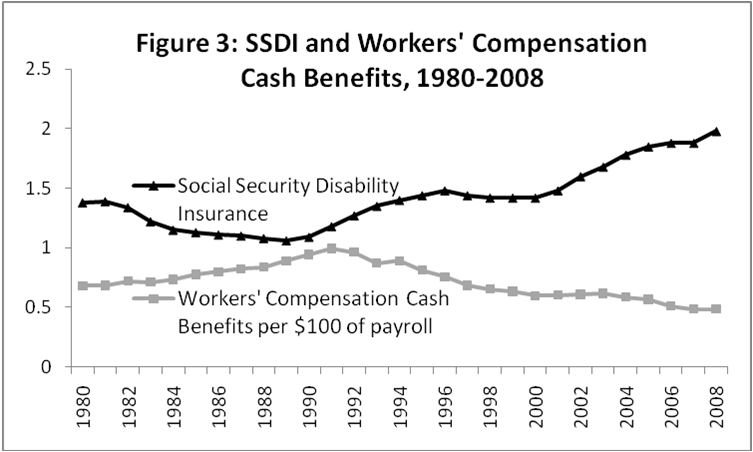For Immediate Release | September 9, 2010
Contact:
Jill Braunstein at (202) 452-8097 or jillbraun@nasi.org
To download a PDF of the full report, click here.
To download a PDF of this release, click here.
WASHINGTON, DC— Workers’ compensation payments for medical care and cash benefits for U.S. workers injured on the job increased 4.4 percent to $57.6 billion in 2008, according to a study released today by the National Academy of Social Insurance (NASI). For the first time, medical benefits accounted for over half (50.4 percent) of all benefits paid. An 8.8 percent increase in payments for medical care drove medical spending to $29.1 billion in 2008 (the most recent year with complete data), while wage replacement benefits paid directly to injured workers rose by 0.3 percent to $28.6 billion (Figure 1).
|
Figure 1: Workers’ Compensation Spending, 2008
|
||
|
Type of Spending
|
Billions of Dollars
|
Percent Change
|
|
Total benefits paid
|
$57.6
|
4.4
|
|
Medical payments
|
29.1
|
8.8
|
|
Cash benefits
|
28.6
|
0.3
|
|
Employer costs
|
78.9
|
-6.7
|
|
Amount per $100
of Covered Wages |
Per $100 of Payroll
|
Dollar Change
|
|
Benefits paid
|
$0.97
|
$0.03
|
|
Medical payments
|
0.50
|
0.03
|
|
Cash payments to workers
|
0.48
|
-0.01
|
|
Employer costs
|
1.33
|
-0.11
|
|
Source: National Academy of Social Insurance, 2010.
|
||
The growth in medical spending may reflect both higher prices for medical care and greater use of services,” said John F. Burton, Jr., chair of the panel that oversees the report. “The increase is the continuation of a long-term trend since 1980, but this is the first year that payments for medical care were more than half of all workers’ compensation benefits.”
Employers paid a total of $78.9 billion nationwide for workers’ compensation, a decrease of 6.7 percent from the previous year.

For long-term trends, it is useful to consider workers’ compensation benefits per $100 of payroll covered by the program. By this measure, cash benefits were $0.48 per $100 of payroll in 2008. This is the lowest level since 1980 (the earliest date with comparable data).
As workers’ compensation cash benefits as a share of covered payroll declined over the years, Social Security benefits continued to rise. The opposite trends in workers’ compensation cash benefits and Social Security disability benefits during much of the last twenty-five years raise the question of whether retrenchments in one program increase demands placed on the other, and vice versa. “The substitutability of Social Security disability benefits and workers’ compensation cash benefits for workers with severe, long-term disabilities that are work-related or might be exacerbated by the demands of work is an important question for researchers and policy makers” according to Burton.

The new report, Workers’ Compensation: Benefits, Coverage and Costs, 2008, is the thirteenth report in the NASI series that provides the only comprehensive data on workers’ compensation cash and medical payments for the nation and for each state, the District of Columbia, and federal programs.
NOTE TO REPORTERS AND EDITORS: The full report is available by clicking here. For a copy of the printed report, media can contact Jill Braunstein at (202) 452-8097 or by e-mail at jillbraun@nasi.org. All others should contact Ishita Sengupta at isengupta@nasi.org.
|
Ishita Sengupta
National Academy of Social Insurance
(202) 452-8097
isengupta@nasi.org |
Virginia Reno
National Academy of Social Insurance
(202) 452-8097
|
John F. Burton, Jr.
Rutgers University and
Cornell University
(732) 274-0600
|
|
Leslie Boden
Boston University
(617) 638-4635
|
Robert Reville
RAND
(310) 393-0411
|
The National Academy of Social Insurance is a nonprofit, nonpartisan organization made up of the nation’s leading experts on social insurance. Its mission is to promote understanding of how social insurance contributes to economic security and a vibrant economy.
See related news: Disability, Workers' Compensation, Workforce Issues and Employee Benefits
